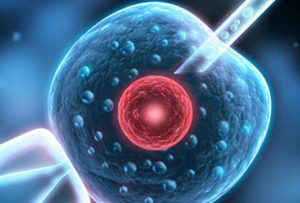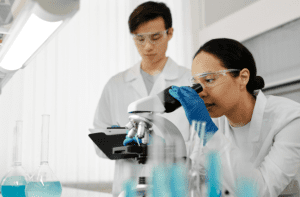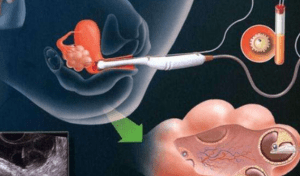Follicle development is a crucial process in the female reproductive system that directly affects ovulation and pregnancy success. The healthy development of follicles is not only dependent on the balance of hormones in the body, but is also closely related to nutritional status, lifestyle and many other factors. Understanding the whole process of follicular development and the criteria for follicular maturity can help women better manage their reproductive health and improve their chances of conception.

The four stages of follicular development
1. Primordial follicle stage
Primordial follicles are the starting point of follicular development, and they are present in the ovary when a woman is born. Each primordial follicle contains a primary oocyte surrounded by a layer of flattened follicular cells. Primordial follicles are usually dormant and are only activated during specific phases of the menstrual cycle. Despite their large numbers, only a small percentage of primordial follicles move on to the next stage of development in a lifetime.
During the embryonic stage of development, there are approximately millions of primordial follicles in the ovaries of the female fetus. The number of these follicles decreases significantly at birth to about 1 to 2 million. By puberty, only about 300,000 to 500,000 primordial follicles remain in a woman's ovaries. These follicles are gradually activated and developed during each menstrual cycle.
2. Primary follicular stage
After sexual maturation, a number of primordial follicles are activated and develop into primary follicles during each cycle. At this time, the oocyte gradually enlarges and the surrounding follicular cells change from flat to cuboidal or columnar and gradually proliferate into multiple layers. At this stage, the primary follicle forms a zona pellucida between the primary oocyte and the follicular cells, which separates the oocyte from the surrounding granulosa cells.
Primary follicle formation is regulated by follicle stimulating hormone (FSH) Fluctuations in FSH levels affect the number and quality of primary follicles. During each cycle, approximately 1000 primordial follicles are activated, but only a small percentage will develop into primary follicles. The rest of the follicles undergo atresia and degeneration during the early stages of development.
3. Secondary follicular stage
Secondary follicles are marked by the appearance of follicular fluid and the formation of follicular cavities. Small cavities gradually appeared between the follicular cells, and these gradually fused to form a larger follicular cavity, which was filled with follicular fluid. As the follicular cavity expanded, the primary oocytes, zona pellucida, and some surrounding follicular cells were pushed to one side of the follicle, forming an egg mound. At this point, the follicular cells immediately surrounding the follicular cavity form a follicular wall called the granulosa.
The development of the secondary follicular stage is regulated by a variety of hormones and growth factors. In addition to FSH and LH, inhibin and activin play important roles in this process. Inhibin is secreted by granulosa cells and inhibits FSH secretion, preventing excessive follicular development. Activin, on the other hand, promotes FSH secretion and supports continued follicular development.

4. Mature follicle stage
When follicles increase significantly in size, up to 18-23 millimeters in diameter, they are called mature follicles. Mature follicles protrude toward the surface of the ovary and have the ability to ovulate. At this point, the follicular structures are, in order from outside to inside, the outer follicular membrane, the inner follicular membrane, the granulosa cells, the follicular chambers, the egg mound and the radial crown. Only at this stage can the follicle release a mature egg at ovulation.
The formation of mature follicles is strongly stimulated by luteinizing hormone (LH).The peak of LH usually occurs within 24 to 36 hours before ovulation, prompting the follicle to rupture and release the egg. This process is known as ovulation. After ovulation, the remnants of the follicle transform into the corpus luteum, which secretes progesterone to support early pregnancy.
What factors affect follicle development
1. Endocrine hormones
Endocrine hormones play a crucial role in follicular development. Follicle stimulating hormone (FSH) and luteinizing hormone (LH) are the main regulatory hormones for follicular development.FSH promotes follicular growth and granulosa cell proliferation, while LH plays a key role in follicular maturation and ovulation. In addition, estrogen and progesterone are also involved in the regulation of follicular development.
Estrogen plays an important role in all stages of follicular development. It not only promotes the proliferation and differentiation of follicular cells, but also regulates the secretion levels of FSH and LH through a negative feedback mechanism. Progesterone is secreted by the corpus luteum after ovulation, and its main role is to maintain the endometrium and provide support for fertilized egg attachment and pregnancy.

2. Nutritional status
Nutritional status directly affects follicle development. Adequate nutrition ensures proper follicle development, while inadequate nutrition may result in poor or arrested follicle development. Vitamins, minerals and proteins are essential nutrients for follicle development, especially vitamin E, zinc and selenium, which play an important role in healthy follicle development.
Research has shown that deficiencies in specific vitamins and minerals can lead to ovarian dysfunction. For example, vitamin D deficiency may be associated with polycystic ovary syndrome (PCOS), while zinc and selenium deficiencies may affect antioxidant mechanisms and, in turn, follicular cell health. Essential fatty acids in the diet are also critical to the structure and function of follicular cell membranes.
3. Lifestyle
Lifestyle also has a significant impact on follicle development. Smoking, alcohol consumption and irregular work schedules can negatively affect follicle development. In addition, chronic stress and anxiety may also interfere with the endocrine system, which in turn affects the normal development of the follicles. Therefore, maintaining a healthy lifestyle and a good psychological state is essential for follicle development.
Smoking is recognized as one of the important risk factors for premature ovarian failure. Smokers usually have lower follicular quality and significantly reduced ovarian reserve. Alcohol, on the other hand, affects the balance of estrogen and progesterone, which may lead to irregular periods and abnormal ovulation. A regular routine and proper exercise can improve hormone levels and contribute to healthy follicle development.
4. Age factor
Age is one of the most important factors affecting follicle development. The number and quality of follicles decreases with age, and after the age of 35, a woman's ovarian function begins to decline significantly, as does the rate and quality of follicle development. This is why it is more difficult for women to conceive after the age of 35 and the risk of miscarriage increases accordingly.
Statistics show that the number of follicles in a woman's ovaries declines by about 51 TP3T to 101 TP3T per year after the age of 35. This decline accelerates after the age of 40. The decline in follicle quality is also accompanied by an increased risk of chromosomal abnormalities, leading to a higher probability of pregnancy failure and fetal malformations. Age is therefore a key factor in fertility.
What follicle size is considered mature?
1、Normal range of follicle size
In a normal menstrual cycle, it takes about 14 days for a follicle to develop from a primary follicle to a mature follicle. On the eve of ovulation, mature follicles are usually between 18 and 23 millimeters in diameter. Follicles in this range are considered mature and capable of ovulation and fertilization. Follicles larger than 23 millimeters may form cysts, while follicles smaller than 18 millimeters may not ovulate successfully.
Statistics show that normally, approximately 751 TP3T women have mature follicles between 18 and 20 mm in diameter prior to ovulation. Only 51 women with TP3T will have follicles greater than 23 millimeters prior to ovulation, and these follicles usually require further medical evaluation and intervention.
2. Speed of follicle development
The rate at which follicles develop during the menstrual cycle is an important indicator for assessing their health. In general, from day 1 to day 14 of the menstrual cycle, the follicle grows at a daily rate
It is about 1-2 millimeters. As the follicle gradually increases in size, the hormone levels in the ovary change, especially the concentration of estrogen, which gradually increases in preparation for ovulation.
Studies have shown that the rate of follicle development is closely related to FSH levels. High FSH levels are usually accompanied by faster follicular development, while low FSH levels may result in slow or stagnant follicular development. Therefore, the monitoring of FSH levels is important in assessing follicular development.
3. Functional assessment of follicles
The doctor assesses the function of the follicles by monitoring their size and development through ultrasound. The doctor will closely monitor the growth of the follicles 2-3 days prior to ovulation and depending on the size of the follicles will decide whether ovulation induction or other assisted reproductive techniques are needed. If the follicles develop normally and meet the maturity criteria, the doctor will recommend natural ovulation or artificial insemination.
Ultrasound monitoring is often combined with measurement of serum hormone levels to provide a more complete assessment. In addition to FSH and LH, changes in estrogen and progesterone levels can also reflect follicular development. By analyzing these data together, doctors can develop a personalized treatment plan to improve the success rate of conception.

Relationship between follicle size and endothelial thickness
There is a close relationship between follicle size and endometrial thickness. Normally, as the follicle develops, the endometrium thickens in preparation for the implantation of a fertilized egg. In general, the thickness of the endometrium should be between 8 and 14 millimeters prior to ovulation, which is ideal for embryo implantation and pregnancy.
Changes in endothelial thickness are closely related to hormonal regulation of follicular development. Rising estrogen levels promote proliferation of endothelial cells, while progesterone maintains the stability and function of the endothelium after ovulation. Therefore, the measurement of endothelial thickness can indirectly reflect ovarian function and follicular development.
Endothelial thickness corresponding to different follicle sizes
The thickness of the endometrium varies at different stages of follicular development. Below is an approximate reference of follicle size corresponding to endometrial thickness:
- When the follicle is less than 10 millimeters, the endometrial thickness is usually less than 5 millimeters.
- When the follicle size is between 12 and 14 millimeters, the endometrial thickness is usually between 6 and 8 millimeters.
- When the follicle size is between 16 and 18 millimeters, the endometrial thickness is usually between 8 and 10 millimeters.
- When the follicle size reaches 18 to 25 millimeters, the endometrial thickness is usually between 9 and 14 millimeters.
The above comparison table is an average value based on a large amount of clinical data, which may vary between individuals. By monitoring changes in follicle size and lining thickness, doctors can more accurately determine the timing of ovulation and the window for conception, improving the success rate of assisted reproductive technology.
Effects of abnormal endothelial thickness
If the thickness of the uterine lining is not within the normal range, it may interfere with the implantation of the embryo and the pregnancy. For example, an endometrium that is too thin may not be able to provide sufficient nutrients and support, resulting in the embryo not successfully implanting. An excessively thick endometrium, on the other hand, may be associated with hormonal imbalances or other pathologies that are equally unfavorable for pregnancy. Therefore, doctors monitor follicular development while keeping a close eye on the thickness of the endometrium and intervene accordingly.
Causes of thin endometrium may include low hormone levels, inflammation or damage to the endometrium. Treatments include hormone supplementation, anti-inflammatory treatments and endometrial repair surgery. Thickness of the lining, on the other hand, may be associated with conditions such as endometrial hyperplasia and endometrial cancer, and treatments include medication and surgical intervention.
Causes and treatment of follicular dysplasia
Common causes of follicular dysplasia
Follicular dysplasia is one of the major causes of infertility. Common factors that lead to follicular dysplasia include:
- Endocrine disorders: Abnormalities in FSH, LH, estrogen and progesterone levels can affect the normal development of follicles.
- Polycystic Ovary Syndrome (PCOS): Patients with PCOS usually have impaired follicular development, resulting in non-ovulation or irregular ovulation.
- Premature Ovarian Failure (POF): Premature Ovarian Failure leads to a decrease in the number and quality of follicles.
- Malnutrition: Lack of essential nutrients affects the proliferation and differentiation of follicular cells.
- Lifestyle factors: Smoking, alcohol consumption, stress and irregular routines can disrupt the endocrine system and affect follicular development.
Treatment of follicular dysplasia
Treating follicular dysplasia requires measures based on the specific cause. Common treatments include:
- Hormone therapy: By supplementing FSH, LH, estrogen and progesterone, the endocrine balance can be regulated and normal follicular development can be promoted.
- Medication: Ovulation-promoting drugs such as clomiphene and gonadotropin-releasing hormone (GnRH) analogs can be used for conditions such as PCOS.
- Nutritional supplementation: Improvement of the nutritional status of the follicles through dietary modifications and vitamin and mineral supplementation.
- Lifestyle interventions: Stopping smoking, limiting alcohol, reducing stress and maintaining a regular routine can improve the functioning of the endocrine system.
- Assisted Reproductive Technology: For follicular dysplasia that is difficult to resolve through conventional methods, assisted reproductive technology such as in vitro fertilization (IVF) can be used.
summarize
The process of follicle development is a critical part of a woman's reproductive cycle and affects the success of ovulation and pregnancy. Understanding the four stages of follicular development, the factors that affect follicular development and the criteria for follicular maturity can help women better manage their reproductive health. Through scientific monitoring and assessment, combined with a healthy lifestyle and appropriate medical interventions, women can improve the quality of follicular development and their chances of successful conception.






